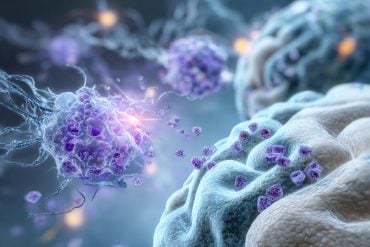Summary: Low doses of carbon monoxide, similar to levels experienced by smokers, can protect against neurodegeneration in Parkinson’s disease models. Researchers discovered that carbon monoxide reduced the accumulation of the Parkinson’s-associated protein alpha-synuclein and activated pathways that limit oxidative stress.
These findings suggest that molecular mechanisms triggered by low-dose carbon monoxide could slow the progression of Parkinson’s disease. A clinical trial to test this therapy in Parkinson’s patients is being planned.
Key Facts:
- Low doses of carbon monoxide protected rodents from Parkinson’s-like neurodegeneration.
- It reduced alpha-synuclein buildup and activated stress-reducing pathways.
- A clinical trial for low-dose carbon monoxide in Parkinson’s patients is planned.
Source: Harvard
Paradoxically, previous research has shown that despite its inherent health risks, cigarette smoking is linked with a reduced risk of Parkinson’s disease. Until now, however, it was not clear how.
New research in lab models indicates that low doses of carbon monoxide — comparable to that experienced by smokers — protected against neurodegeneration and prevented the accumulation of a key Parkinson’s-associated protein in the brain.
The findings are published in npj Parkinson’s Disease by investigators at Massachusetts General Hospital.

“Because smoking has consistently been associated with a reduced risk of Parkinson’s disease, we wondered whether factors in cigarette smoke may confer neuroprotection,” said senior author Stephen Gomperts, an attending physician at Massachusetts General Hospital and an associate professor of neurology at Harvard Medical School.
“We considered carbon monoxide in part because it is generated endogenously in response to stress and has been shown to have protective properties at low levels. Also, overexpression of heme oxygenase-1, a stress-induced enzyme that produces endogenous carbon monoxide, has been found to protect dopaminergic neurons from neurotoxicity in an animal model of Parkinson’s.”
In addition, nicotine, a major constituent of cigarette smoke, has been found to be ineffective at slowing the disease’s progression in a recently reported clinical trial.
These findings led Gomperts and his colleagues to test the effects of low doses of carbon monoxide in rodent models of Parkinson’s.
They administered a low dose of carbon monoxide (comparable to the exposure experienced by people who smoke) in the form of an oral drug product provided by Hillhurst Biopharmaceuticals, and found it protected the rodents against hallmark features of the disease, including the loss of dopaminergic neurons and the accumulation of the Parkinson’s-associated protein alpha-synuclein in neurons. Mechanistically, low-dose carbon monoxide activated signaling pathways that limit oxidative stress and degrade alpha-synuclein.
The team also found that heme oxygenase-1 was higher in the cerebrospinal fluid of people who smoke compared with nonsmokers. And in brain tissue samples from patients with Parkinson’s, heme oxygenase-1 levels were higher in neurons that were free of alpha-synuclein pathology.
“These findings suggest that molecular pathways activated by low-dose carbon monoxide may slow the onset and limit the pathology in Parkinson’s disease. They support further investigation into low-dose carbon monoxide and the pathways it modifies to slow disease progression,” said Gomperts.
“Building on multiple Phase 1 and Phase 2 clinical studies in both healthy people and people with a variety of clinical conditions showing safety of carbon monoxide at the low doses studied here, a clinical trial of low-dose, orally administered carbon monoxide in patients with Parkinson’s disease is planned.”
Funding: This work was supported by the Farmer Family Foundation Parkinson’s Research Initiative, Michael J. Fox Foundation, National Institutes of Health, and the Challenger Foundation, with in-kind support from Hillhurst Biopharmaceuticals Inc.
About this Parkinson’s disease research news
Author: Brandon Chase
Source: Harvard
Contact: Brandon Chase – Harvard
Image: The image is credited to Neuroscience News
Original Research: Open access.
“Neuroprotection of low dose carbon monoxide in Parkinson’s disease models commensurate with the reduced risk of Parkinson’s among smokers” by Stephen Gomperts et al. npj Parkinson’s Disease
Abstract
Neuroprotection of low dose carbon monoxide in Parkinson’s disease models commensurate with the reduced risk of Parkinson’s among smokers
Paradoxically, cigarette smoking is associated with a reduced risk of Parkinson’s Disease (PD). This led us to hypothesize that carbon monoxide (CO) levels, which are constitutively but modestly elevated in smokers, might contribute to neuroprotection.
Using rodent models of PD based on α-synuclein (αSyn) accumulation and oxidative stress, we show that low-dose CO mitigates neurodegeneration and reduces αSyn pathology.
Oral CO administration activated signaling cascades mediated by heme oxygenase-1 (HO-1), which have been implicated in limiting oxidative stress, and in promoting αSyn degradation, thereby conferring neuroprotection.
Consistent with the neuroprotective effect of smoking, HO-1 levels in cerebrospinal fluid were higher in human smokers compared to nonsmokers.
Moreover, in PD brain samples, HO-1 levels were higher in neurons without αSyn pathology. Thus, CO in rodent PD models reduces pathology and increases oxidative stress responses, phenocopying possible protective effects of smoking evident in PD patients.
These data highlight the potential for low-dose CO-modulated pathways to slow symptom onset and limit pathology in PD patients.







